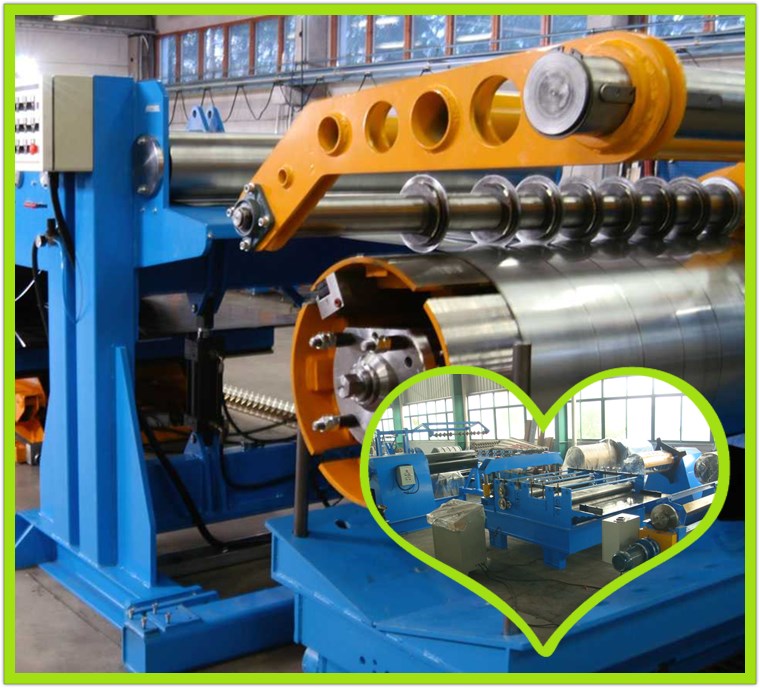High speed steel coil slitting lines
A Slitting Line is used to break master coils down into smaller coils of a specific width and or weight. A Slitting Line will uncoil a master coil and slit it to a specified width(s). The slit coils sometimes referred to as “mults” or “strips” are then recoiled. The finished slit coils produced by Slitting Lines are used in a wide variety of applications such as roll forming, stamping operations, and tube production. When considering a Slitting Line and the proper line configuration for your application, there are several variables you should consider. The thickness of the material, the type of material, the weight of the coils to be produced, as well as annual volume to be processed all influence the line configuration and capabilities required for a successful installation.
Our high speed slitting lines composed of:
Flexible Coil Storage
Automatic Coil Loading
Automatic Threader
High Precision Circular Shears
Automatic Tooling Change
Edge Trimmer
Deburring Roller
Automatic Loop Control
Double Loop System
Mobile Tensors
Corrective Tensor-Flattener
Off-line Strapping System
Our production is capable of covering all the clientele’s needs and is divided into categories on the basis of dimensions and thickness of the material to machine and production quantities. These parameters make it necessary to divide the cut-to-length cutting lines into LIGHT, MEDIUM and HEAVY.
1. LIGHT up to 15 Ton, 1550 mm, thickness from 0.2 mm to 3 mm, speeds up to 200-350 m/min
2. MEDIUM up to 30 Ton, 1600 mm, thickness from 4 mm to 12.7 mm, speeds up to 150 m/min
3. HEAVY up to 35 Ton, 2200 mm, thickness from 8 mm to 16 mm, speeds up to 20-40 m/min
The slitting lines are therefore able to work thickness from 0.2 mm to 16 mm with working speeds that range from 20 to 350 m/min depending on the needs of the specific customer.

We are a leading manufacture in the industry with high speed slitting, automatic coil feeds and hands free coiling. Used for cutting narrow coil strips from main coils, our machinery comes in many widths and thickness and processes at speeds up to 300m/min.
We build our slitting lines are to maintain high precision while allowing for changes to be made on the fly. High capacity coilers and total control over the machinery with state of the art technology to oversee quality control and automation, we offer our lines on time and on budget!
A slitting line produces longitudinal cuts in a master coil of steel to predetermined narrower widths. These smaller coils or “mults” are then sent to downstream operations such as metal stampers, tube producers or roll forming houses that will use the material in their final product. An slitting line will accommodate from 8” to 96” wide, 5 ton to 60-ton capacity coils and from .006” to 1.00” thick material. Depending on the material thickness and yield strength, speeds from 100 to 2,000 feet per minute can be obtained.

The process begins with loading a coil of steel or master coil onto the uncoiler. The uncoiler can be a dual cone type for heavy gauges or a single end expanding mandrel type for heavy or light gauges. The coil can be loaded into the cones via a pusher type ramp or via a turnstyle and coil car that threads the mandrel of the single end into the inner diameter of the master coil. The hold down presses onto the outside diameter of the master coil and the bands are cut on the master coil. The coil is rotated off the cones or mandrel and peeled to allow the head of the coil to enter edge guides prior to the flattener and leveler (if flatness is critical in downstream operations). Next, The slitter, which consists of two parallel arbors mounted with rotary cutting knives.
These knives partially penetrate the coil stock causing a crack or fracture on both sides of the stock, separating the mults from one another. Rubber stripper rings are also employed depending on the material thickness to attain a good edge so no burr is present that will hinder downstream operations. As the material is slit, the far outside edges of the coil have edge trim. This edge trim is taken up on a scrap winder. If the material to be slit is extremely thin, a looping pit can be used to take up the varying thickness of the mults as the edge cuts are generally thinner than the center cuts. The thin the material, the longer the lineal footage in the master coil. The looping pit will take up the additional volume prior to entering the tension stand. The tension stand is located prior to the recoiler. A tensioning device is needed because the master coil is crowned or larger in diameter in the center of its width than at the edges. Without a tension stand, the slit material from the center of the master coil would take up more quickly while the outboard strips would hang loosely. The recoiler is an expanding mandrel type. It usually expands from 20” to 24” in diameter or greater with the use of expansion pads or leaves. The recoiler takes up the slit mults. The recoiler mandrel is fitted with an overarm device which is a shaft with separator discs which prevent interleaving of the narrower coil widths. The position of the discs are directly in-line with the slitting knives. The finished slit mults are banded on the outside diameter and are pushed off of the recoiler mandrel onto an awaiting coil car or turnstyle.
Tel:+86 0317-5670260
Whatsapp:+8617832978885 +8618803375788
Fax:+86 0317-5670259
Email:Web@Geitgroup.com
Address:Room711,Culture building, Beijing Road, Yunhe District, Cangzhou City, Hebei,China
Please feel free to give your inquiry in the form below.We will reply you within 24 hours



